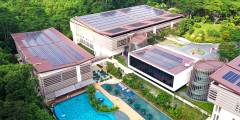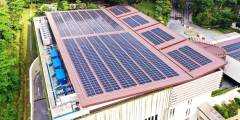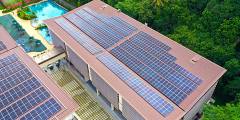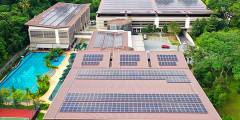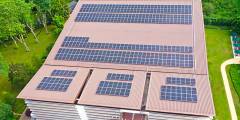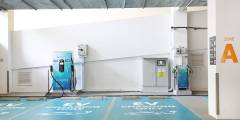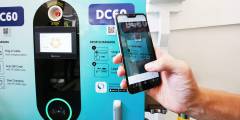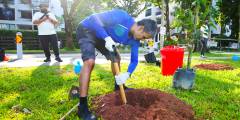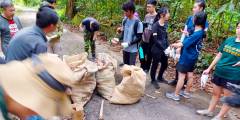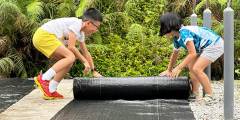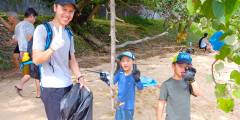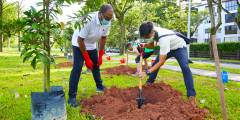
Our Sustainability Journey
Our current Bukit Timah clubhouse was designed and developed to be energy efficient.
In 2015, Temasek Club was awarded with the Green Mark (Platinum) Award by the Building & Construction Authority (BCA). Since then, we continued to strive to achieve better efficiency and implemented various initiatives and supporting measures like solar panels installation, provision of electric vehicle charging points, elimination of the use of plastic with environmentally preferable alternatives, introduction of monitoring devices for water conservation and electricity consumption, etc.
In 2022, our efforts were recognised and our clubhouse was certified as a Green Mark (Super Low Energy) building.
Under the Building Construction Authority’s definitions, this means that Temasek Club is considered among ‘The best-in-class performing Green Mark Building that achieve at least *60% energy savings’.
*This refers to 60% energy savings above 2005 building codes which is being used as the anchor reference for Green Mark energy savings.
The Club will continue to keep its carbon footprint low to do its part toward a greener Nation.
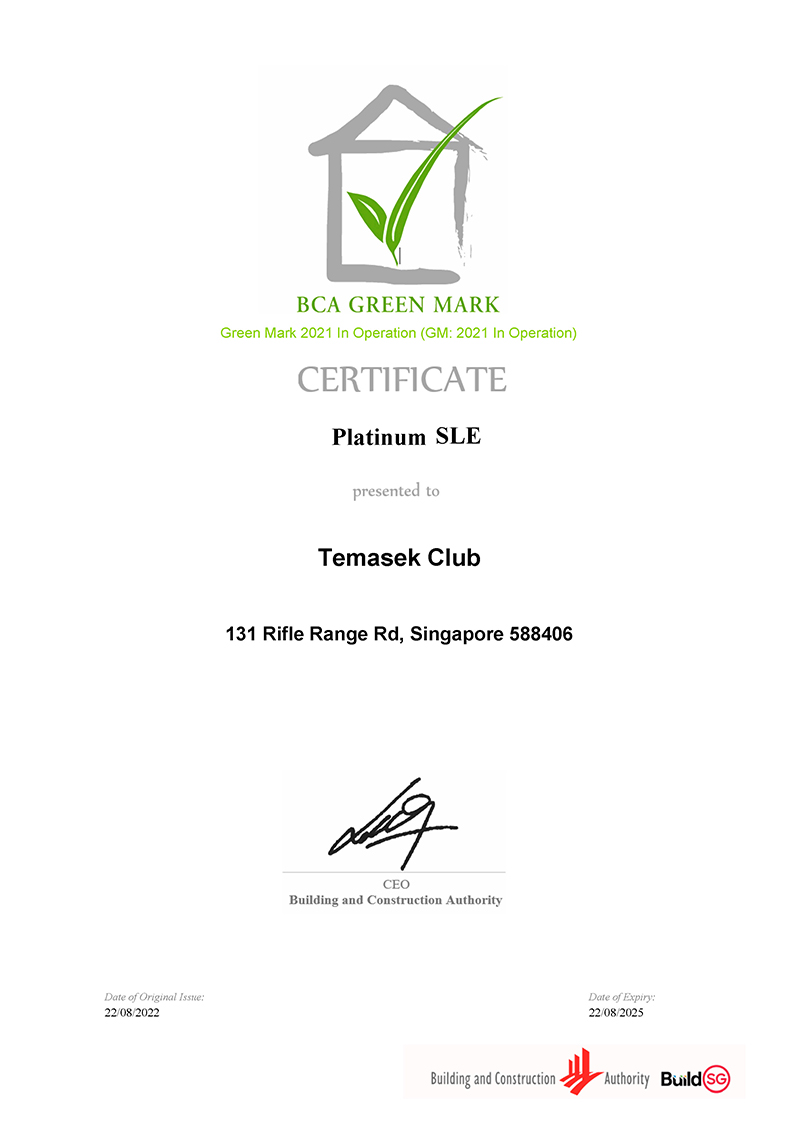
Reducing Our Carbon Footprint
| Electricity Management | EV Charging Facilities |
| Water Management | Waste Management |
| Vertical Greenery | Green Activities |
Temasek Club Green Mark Milestone
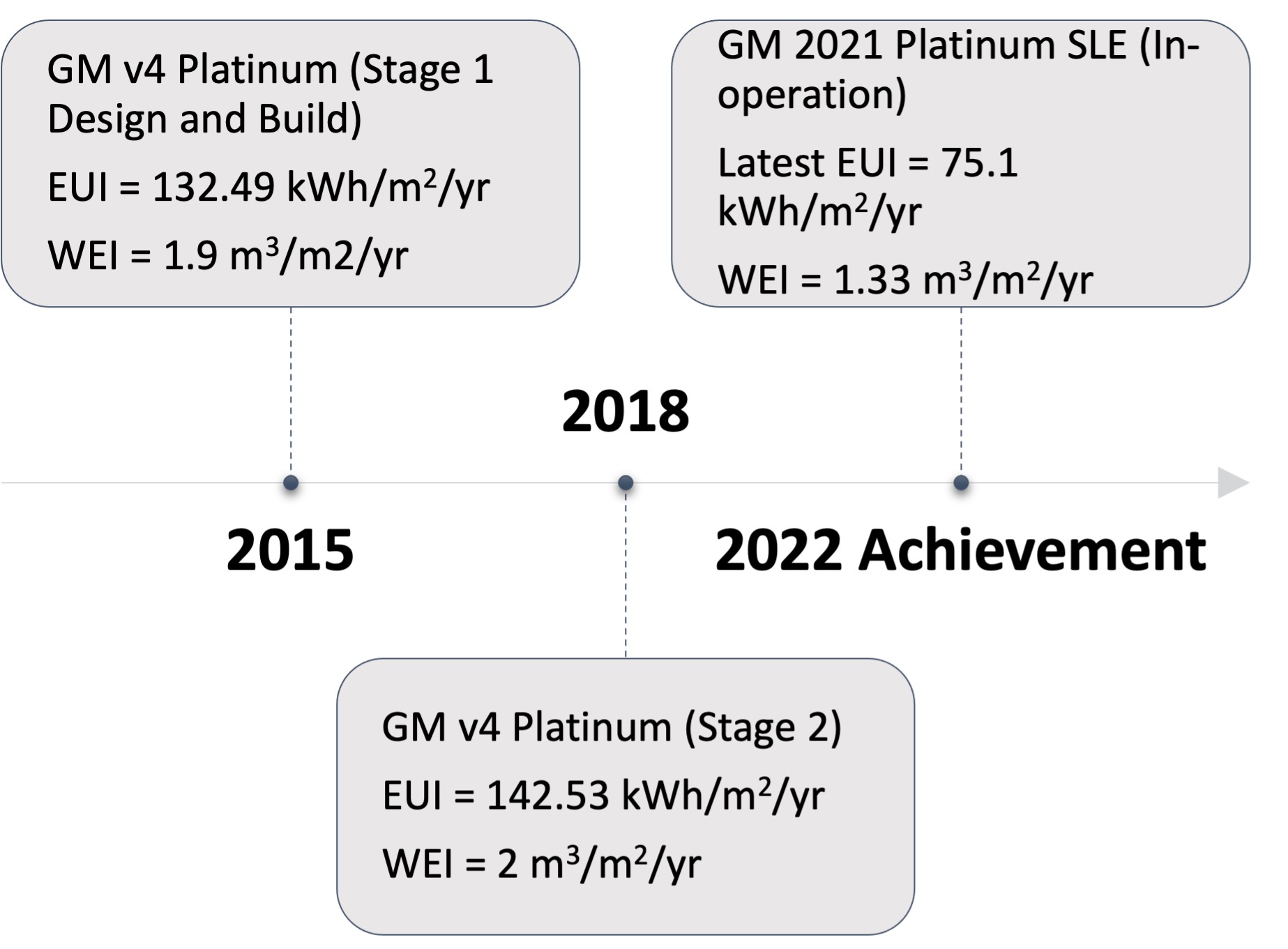
EUI = Energy Use Intensity
WEI = Water Efficiency Index
The lesser the number, the more efficient the building.
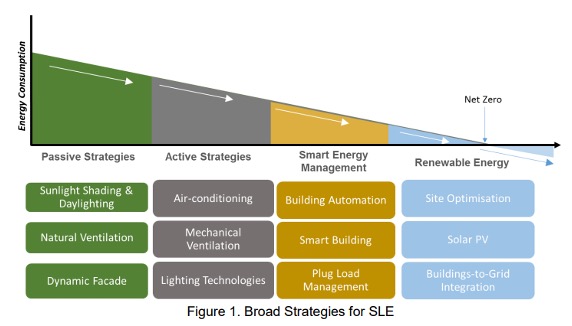
Electricity Management
Smart Electricity Meter
Demand Management
Renewable Energy
Building Management System
Energy efficient appliances

Smart Electricity Meters
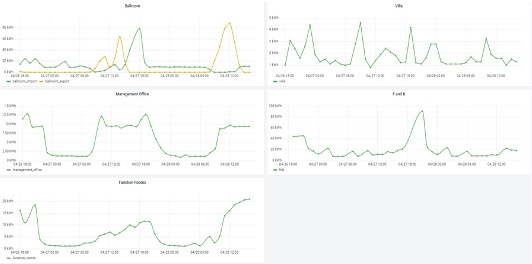
Actively monitor daily electricity usage and abnormal activities in the system.
Analyze new data and make comparison with old data to determine system energy improvement and more saving.
Immediately rectify to minimise power wastage.
Currently, Temasek Club reduced annual electricity demand from national power grid by approximately 1.4 million kWh*, 47% compared to 2019 with the aid of solar energy and improved energy utilization.
*The National Average (from EMA website) electricity consumption of a typical 3-room HDB household is 274 kWh per month or 3,288 kWh per year.
The 1.4M kWh savings can power approximately 425 3-room HDB flats for a year.
Demand Management
Lighting Power Control
Measure the efficiency of the lighting lumen per Code of Practice for lighting of workplaces SS 531 and Code of Practice for Energy efficiency Standard for Building Services and Equipment SS 530 according to space.
Using BMS Zoning Control, motion sensors, photocell sensors, timer controls, dimmer controls, and operation controls to reduce lighting power consumption.
In 2018, the Club replaced all the building lightings with LED and all outdoor standing lamps along the walkways with solar-powered lamp posts.

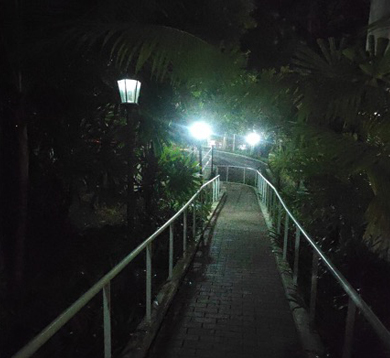
Renewable Energy
The Club has completed the installation of solar panels on our rooftop to harness renewable energy. With this implementation, the Club is now more energy-efficient. Solar Panels operational since 2021. The energy generated from the solar covers about 35% of the overall electricity consumption.
Building Management System (BMS)
Analyze and record difference of Building Cooling Load daily.
Optimize Supply and demand cooling load graph. Control chiller operating hours and setting up chiller low load sleep mode to avoid overcooling (reduce power consumption).
Actively measure room temperature, air flow rate and relative humidity that changes made will still within specification for comfortability, health and well being of occupants.
Average chiller operating power consumption is reduced about 20,000 kWh per month, 25% compared with 2019.
Total chiller plant system efficiency is 0.67 kW/RT @ average cooling load 185RT.
Moving forward, the Club will be exploring the possibility of replacing the existing BMS with Building Energy Management System (BEMS), where it could pair with Internet of Things (IoT) solutions for a more advanced energy management strategy, including the monitoring, aggregation & processing of data to inform logic-controlled responses.
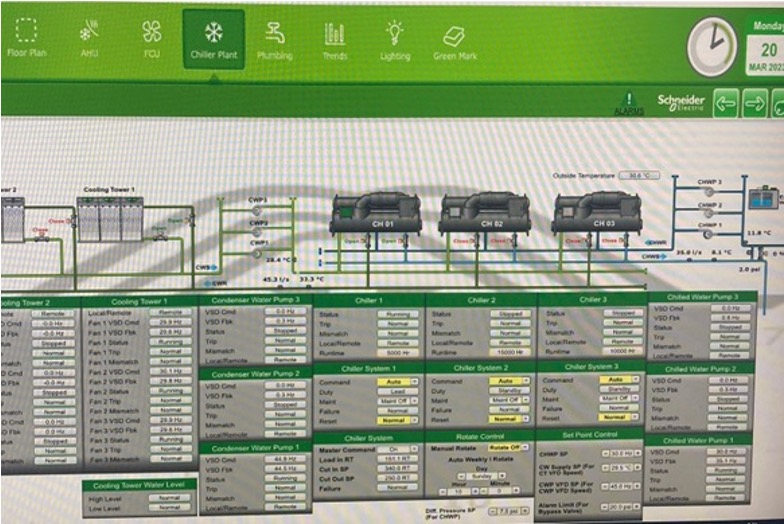
Energy & Water Efficient Appliances
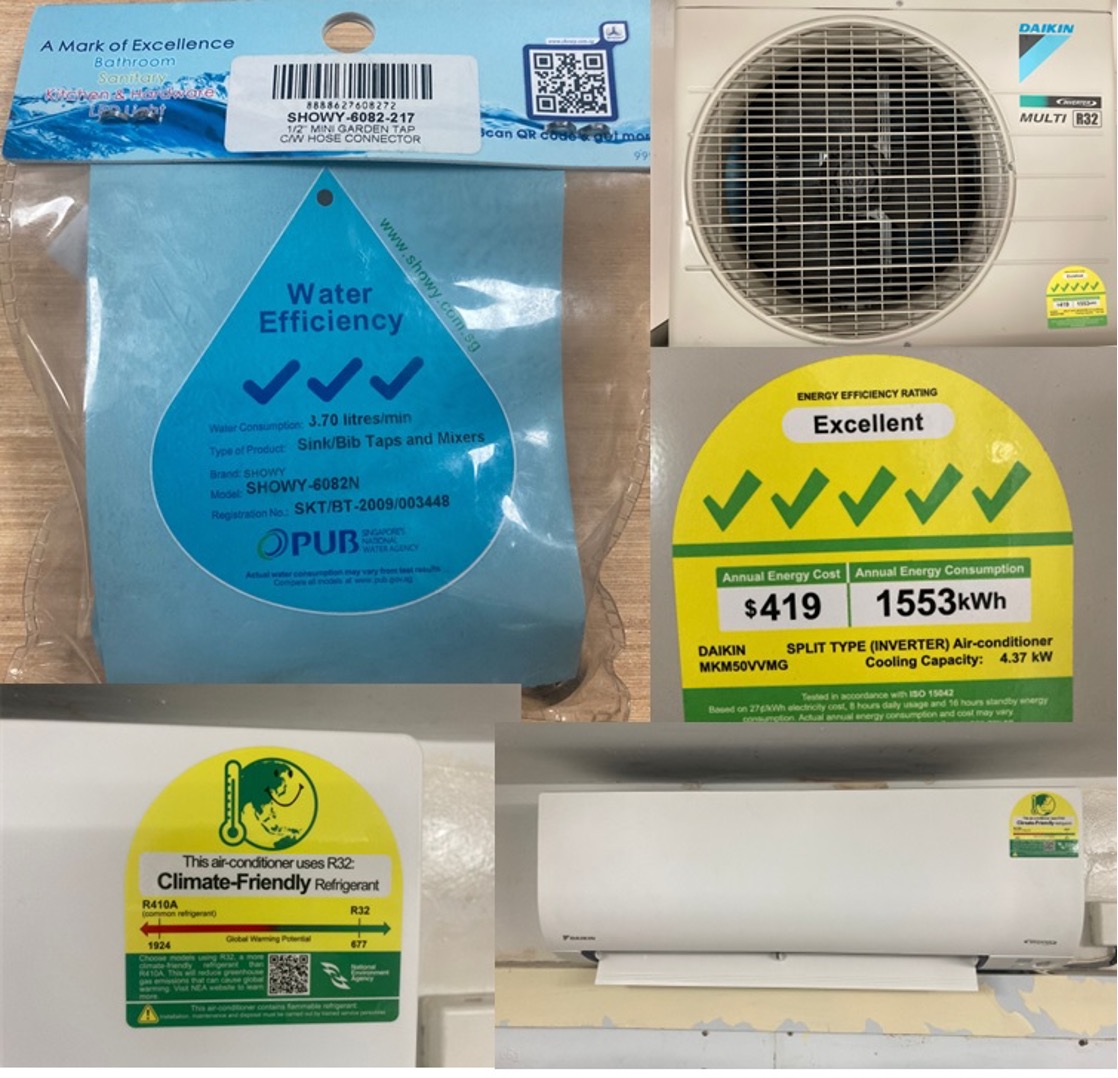
The Club gradually phased out refrigeration and air-conditioning equipment that use high global warming potential (GWP) refrigerants and replaced electrical and water appliances with more energy-efficient models.
Water Management
Smart Water Meters
Cooling Tower
Swimming Pool
Auto-Irrigation System
Water Basin Flow Rate
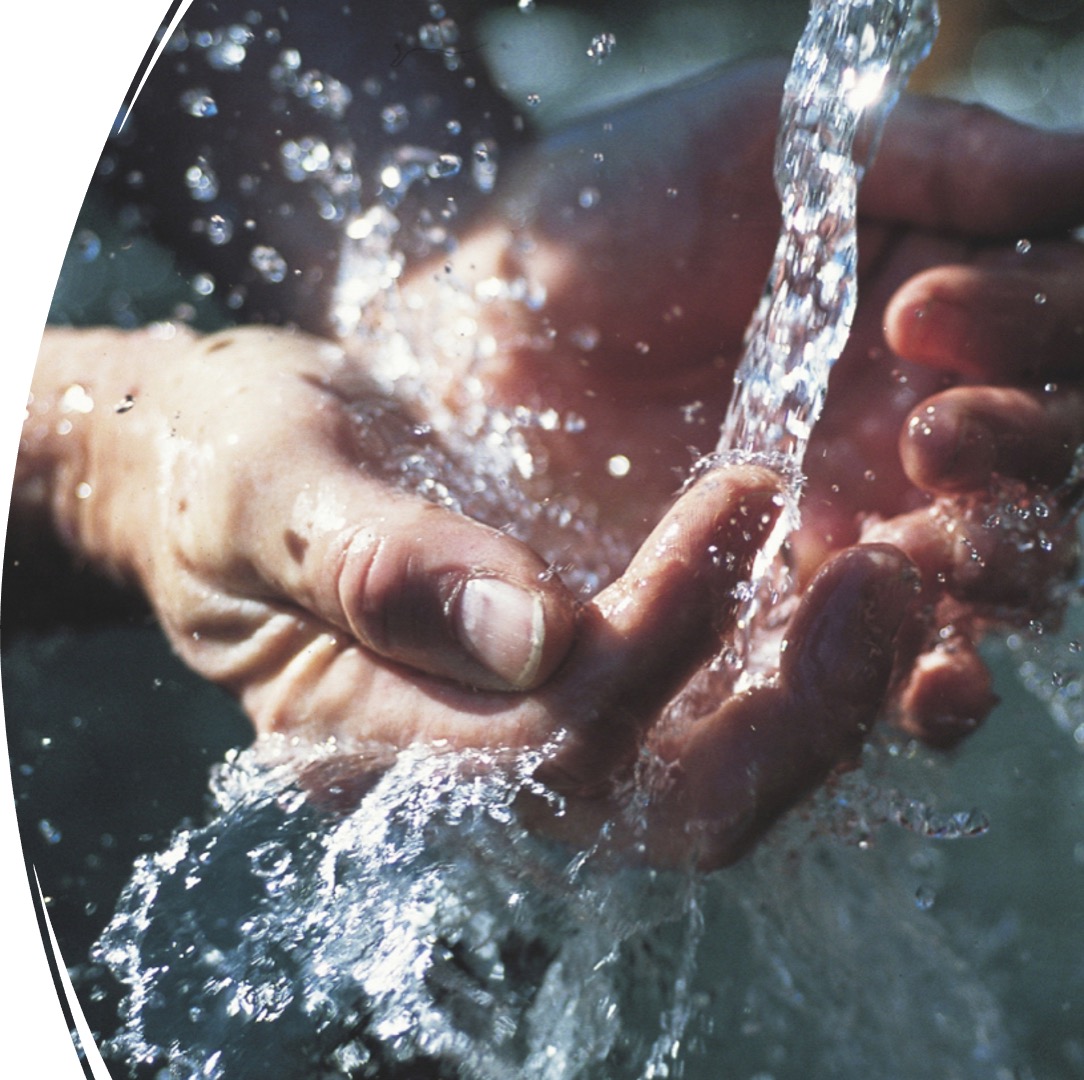
Smart Water Meters
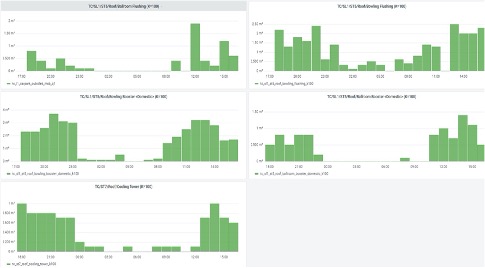
Actively monitor daily water usage, receive reported leakages and abnormal activities in the system.
Detect abnormal activities and repair to reduce water leaking.
Currently, Temasek Club water savings of average at 1,134m3 per month, reduction of 33% than 2019.
*2,500m3 – 1 Olympic-sized Swimming Pool
Conventional Cooling Tower Water Treatment System
Problems Encountered:
- Scaling & Bio-fouling over time.
- Water wastage due to high blow-down rate.
- Higher energy use due to inefficiency in heat transfer.
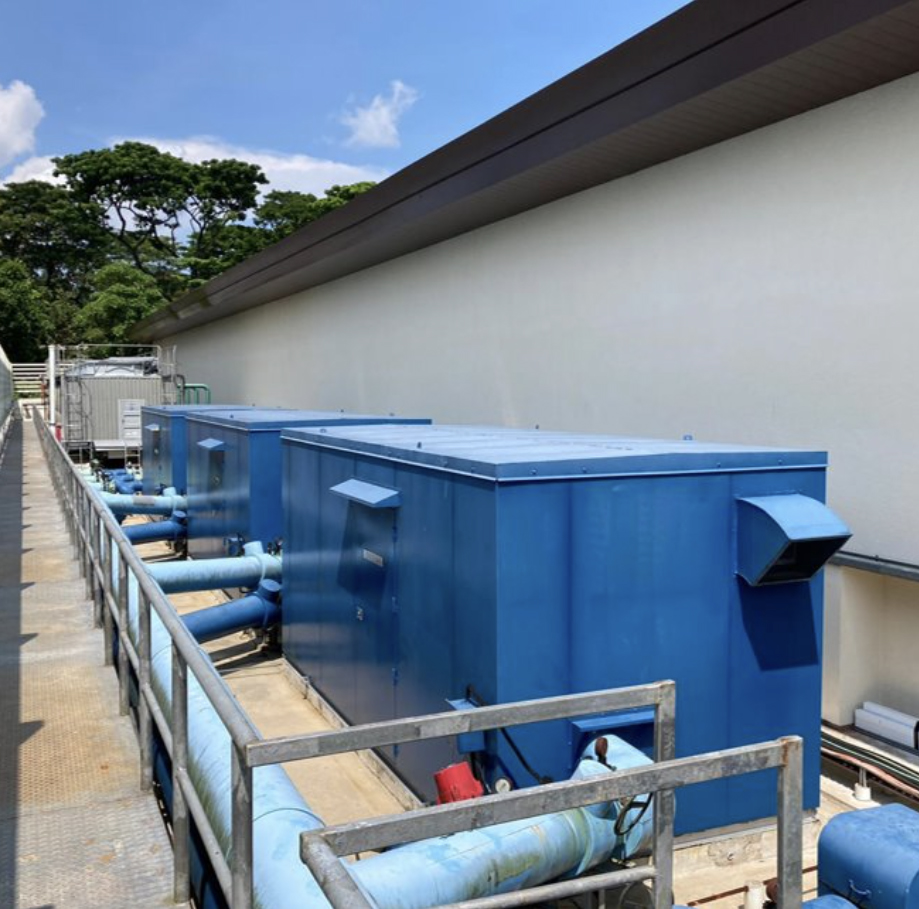
Chemical Free Cooling Tower Water Treatment System
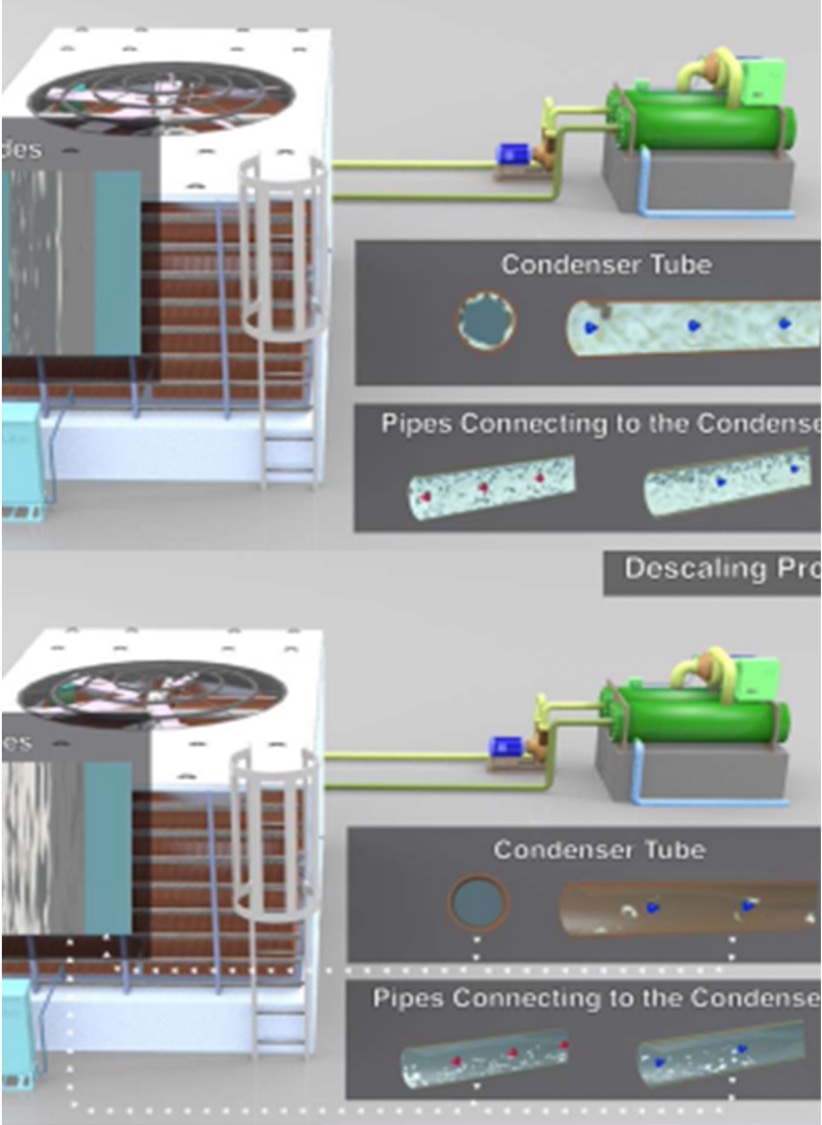
Installed:
- Use Electro Chemical Reaction to resolve scaling issue.
- Improve Cycle of Concentration (COC) about 10.6, hence lesser water blow-down (drained).
- More energy-efficient due to better heat transfer.
- As a result, reduce energy and water consumption.
- New chemical free water treatment system for cooling tower started on Jun 2022.
- After installation and stabilization cooling system, total chiller energy consumption decreased further about average 7,129 kWh per month, reduction of 13% than old system.
- Cooling tower water consumption decreased about average 169m3 per month, reduction of 33% than old system.
Swimming Pool
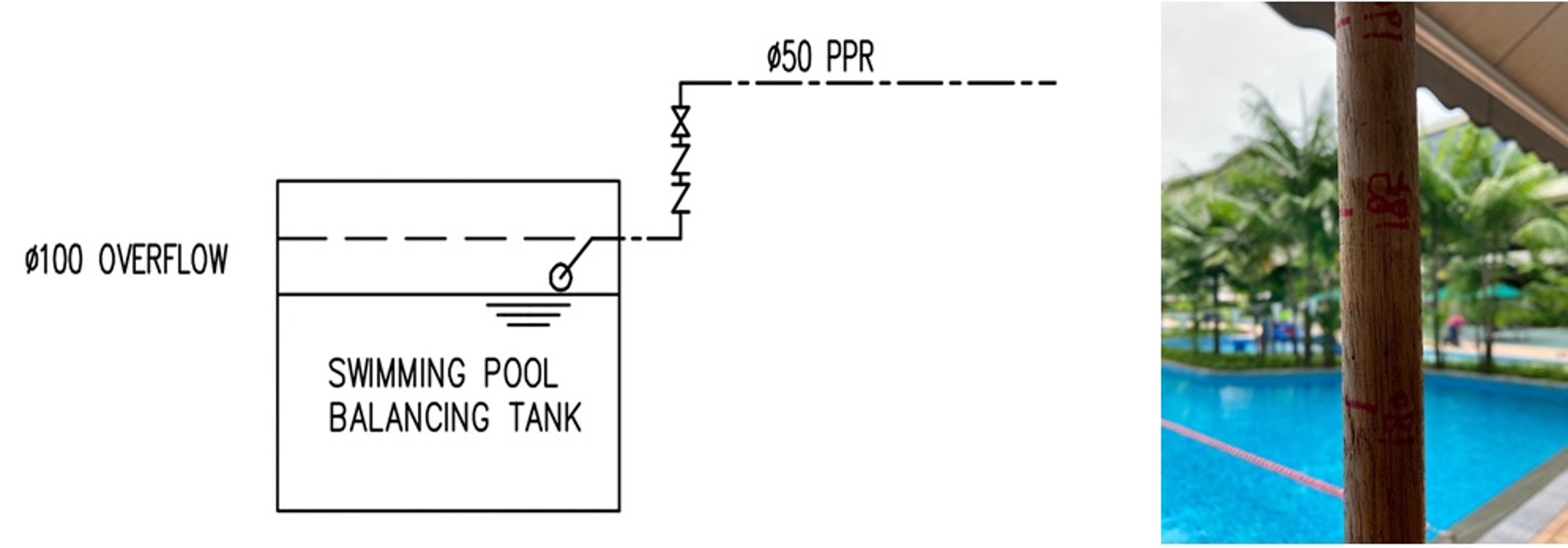
Leakage Control
‘Rainwater Harvesting’ Concept
Balancing Tank Monitoring
Regular testing and maintained swimming pool water quality
Regular backwash sand filters
CY 2022 Annual swimming pool water saving is about 2 ,540m3 which is almost 90% reduction compared to 2021
Auto-Irrigation System
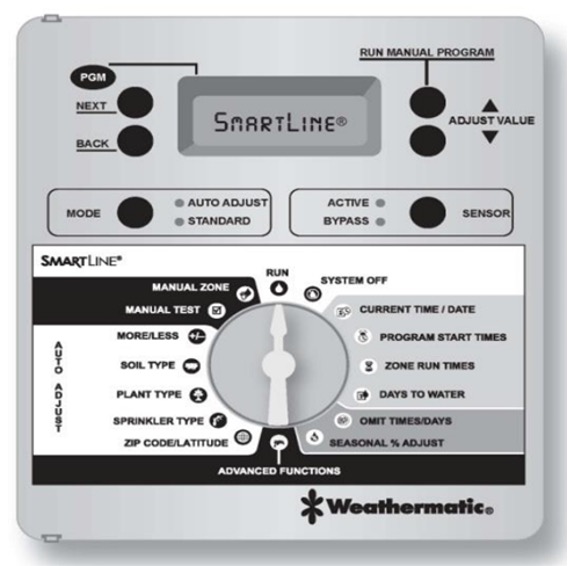
Implemented Solution:
- Installed rain sensors in Jan 22.
- Programmed the timer according to plant species and environment.
- As a result, averagely save about 47m3 per month, 51% reduction of water usage for the Auto Irrigation System.
Water Basin Flow Rate
Comply with mandatory WELS 3 tick requirement.
Requirements can be found in the Singapore Standard CP 48.
Code of Practice for Water Services and the Public Utilities (Water Supply) Regulations.
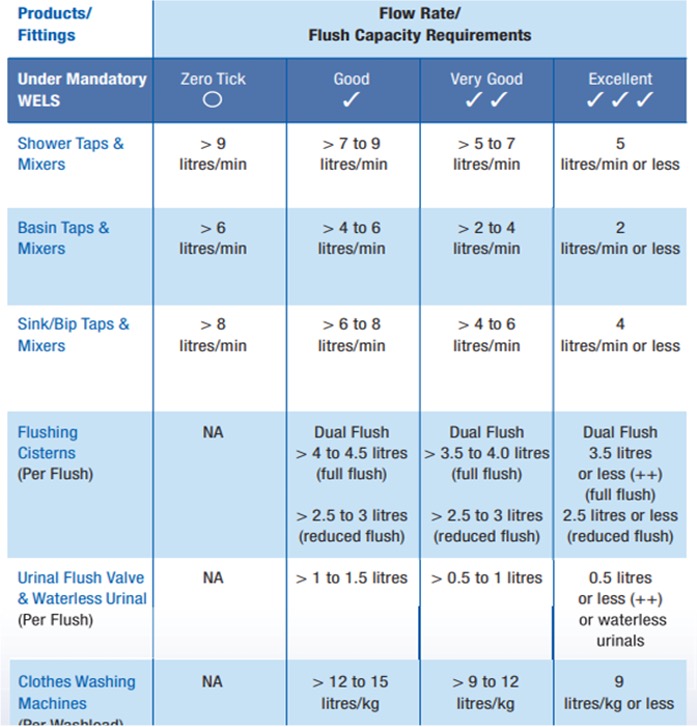
Vertical Greenery
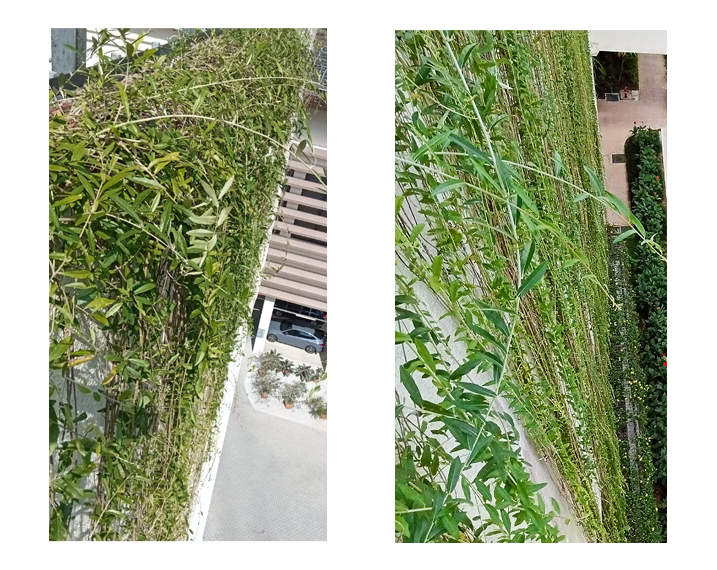
As part of the Club's sustainability effort, we implemented vertical greenery system all around the building to bring a wide range of benefits.
Some advantages include improving overall health by reducing radiation that could have adverse effects on our eyes and skin. It helps filter contaminated air via natural ventilation system and thus improving air quality. In addition, it also plays a crucial role in enhancing indoor thermal environment. Temasek Club building has Envelope Thermal Transfer Value (ETTV) 38.5 W/m2. The Club is designed with low emissivity glass panels that are installed around the building. Together with the external creepers, these block off 39% of solar heat transfer to the surface of our building.
Green facades are also able to mitigate heat and noise from external sources and hence aid in providing a more conducive indoor environment.
Electric Vehicle Charging Points
In line with the nation's roadmap towards a fully electric transport network, we have installed Electric Vehicle (EV) Charging Points in 2021 to help in the transition for members who have switched or are thinking of switching to EVs.
Located at Carpark Zone A, the charging bay comes with two machines with different charging speed – Fast and Normal.
Waste Management
In our bid to minimize wastage, the Club went into e-platform for all its communications and marketing needs. Printing and postage were also re-rationalized and constantly scrutinized in management meetings. As a result of this effort, comparing the financial data of FY19/20 to that of FY16/17, the annual printing and postage cost was reduced by $17k. In addition, waste management was also reviewed and resulted in reduction of waste disposal cost by $32k.
In 2022, the Club further reduced annual general waste about 29,160kg, reduction of 15.4% than 2018. The recyclables waste increased about 18,645kg, reduction of 10.03% than 2018.
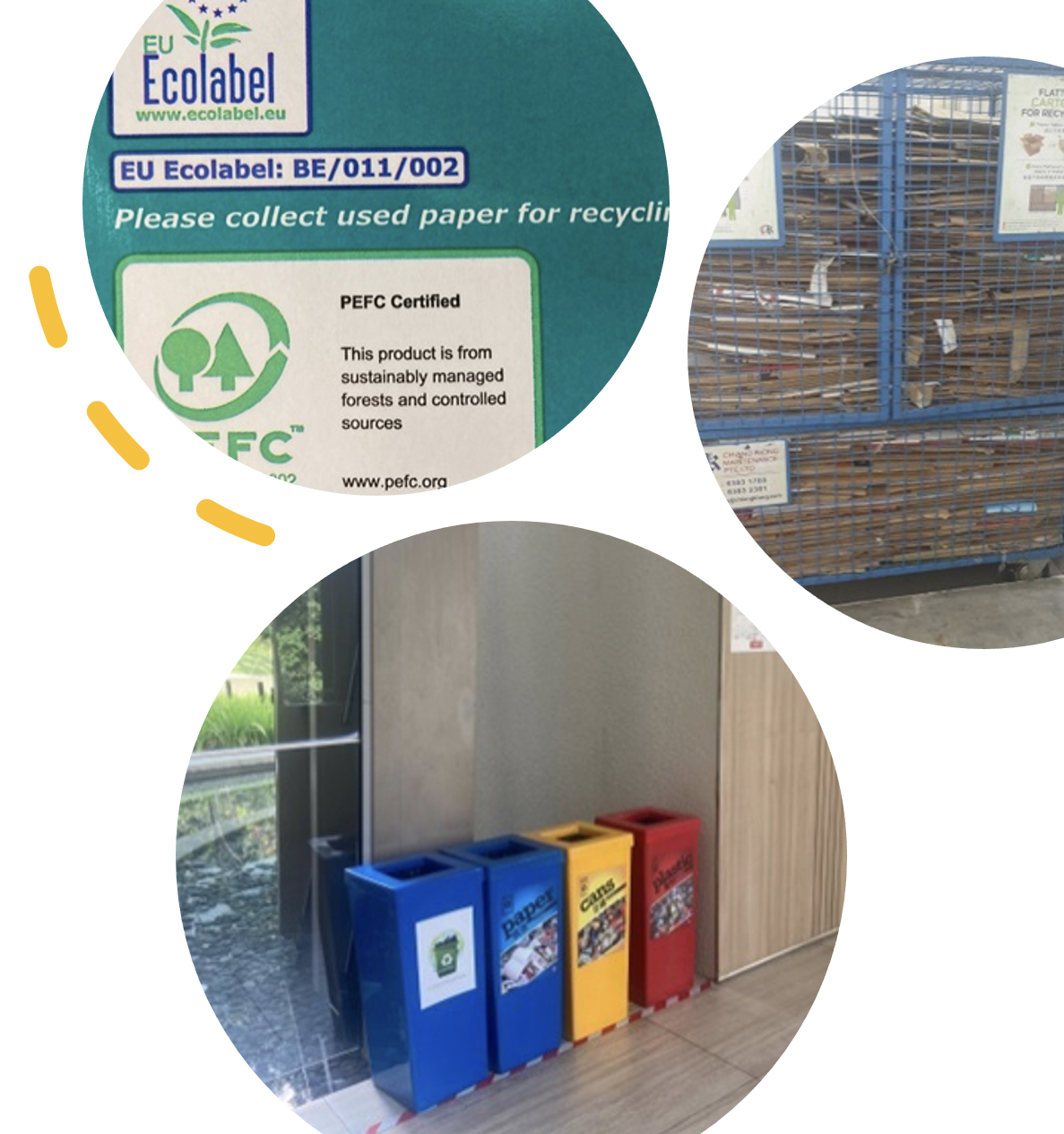
Green Activities and Collaboration with NParks
Since 2019, the Club has stopped providing plastic bags at the pool and gym counters for soiled clothes. In 2021, as part of NParks initiative, the Club has established a staff volunteer group to be part of NParks' various green projects in the Bukit Timah area. This has the potential to subsequently opening to our members to join us, and jointly organize green members' events. The various green projects such as;
- NParks Invasive Species Management
- NParks One Million Trees Movement
- Nature Trail Clean-up
- Sembawang Walk and Beach Clean-up
- Nursery Planting at Rifle Range Nature Park
Our Sustainability Journey
Our current Bukit Timah clubhouse was designed and developed to be energy efficient.
In 2015, Temasek Club was awarded with the Green Mark (Platinum) Award by the Building & Construction Authority (BCA). Since then, we continued to strive to achieve better efficiency and implemented various initiatives and supporting measures like solar panels installation, provision of electric vehicle charging points, elimination of the use of plastic with environmentally preferable alternatives, introduction of monitoring devices for water conservation and electricity consumption, etc.
In 2022, our efforts were recognised and our clubhouse was certified as a Green Mark (Super Low Energy) building.
Under the Building Construction Authority’s definitions, this means that Temasek Club is considered among ‘The best-in-class performing Green Mark Building that achieve at least *60% energy savings’.
*This refers to 60% energy savings above 2005 building codes which is being used as the anchor reference for Green Mark energy savings.
The Club will continue to keep its carbon footprint low to do its part toward a greener Nation.

Reducing Our Carbon Footprint
| Electricity Management | EV Charging Facilities |
| Water Management | Waste Management |
| Vertical Greenery | Green Activities |
Temasek Club Green Mark Milestone


EUI = Energy Use Intensity
WEI = Water Efficiency Index
The lesser the number, the more efficient the building.
Electricity Management

Smart Electricity Meter
Demand Management
Renewable Energy
Building Management System
Energy efficient appliances
Smart Electricity Meters

Actively monitor daily electricity usage and abnormal activities in the system.
Analyze new data and make comparison with old data to determine system energy improvement and more saving.
Immediately rectify to minimise power wastage.
Currently, Temasek Club reduced annual electricity demand from national power grid by approximately 1.4 million kWh*, 47% compared to 2019 with the aid of solar energy and improved energy utilization.
*The National Average (from EMA website) electricity consumption of a typical 3-room HDB household is 274 kWh per month or 3,288 kWh per year.
The 1.4M kWh savings can power approximately 425 3-room HDB flats for a year.
Demand Management
Lighting Power Control
Measure the efficiency of the lighting lumen per Code of Practice for lighting of workplaces SS 531 and Code of Practice for Energy efficiency Standard for Building Services and Equipment SS 530 according to space.
Using BMS Zoning Control, motion sensors, photocell sensors, timer controls, dimmer controls, and operation controls to reduce lighting power consumption.
In 2018, the Club replaced all the building lightings with LED and all outdoor standing lamps along the walkways with solar-powered lamp posts.


Renewable Energy
The Club has completed the installation of solar panels on our rooftop to harness renewable energy. With this implementation, the Club is now more energy-efficient. Solar Panels operational since 2021. The energy generated from the solar covers about 35% of the overall electricity consumption.
Building Management System (BMS)
Analyze and record difference of Building Cooling Load daily.
Optimize Supply and demand cooling load graph. Control chiller operating hours and setting up chiller low load sleep mode to avoid overcooling (reduce power consumption).
Actively measure room temperature, air flow rate and relative humidity that changes made will still within specification for comfortability, health and well being of occupants.
Average chiller operating power consumption is reduced about 20,000 kWh per month, 25% compared with 2019.
Total chiller plant system efficiency is 0.67 kW/RT @ average cooling load 185RT.
Moving forward, the Club will be exploring the possibility of replacing the existing BMS with Building Energy Management System (BEMS), where it could pair with Internet of Things (IoT) solutions for a more advanced energy management strategy, including the monitoring, aggregation & processing of data to inform logic-controlled responses.

Energy and Water Efficient Appliances

The Club gradually phased out refrigeration and air-conditioning equipment that use high global warming potential (GWP) refrigerants and replaced electrical and water appliances with more energy-efficient models.
Water Management

Smart Water Meters
Cooling Tower
Swimming Pool
Auto-Irrigation System
Water Basin Flow Rate
Smart Water Meters

Actively monitor daily water usage, receive reported leakages and abnormal activities in the system.
Detect abnormal activities and repair to reduce water leaking.
Currently, Temasek Club water savings of average at 1,134m3 per month, reduction of 33% than 2019.
*2,500m3 – 1 Olympic-sized Swimming Pool
Conventional Cooling Tower Water Treatment System
Problems Encountered:
- Scaling & Bio-fouling over time.
- Water wastage due to high blow-down rate.
- Higher energy use due to inefficiency in heat transfer.

Chemical Free Cooling Tower Water Treatment System

Installed:
- Use Electro Chemical Reaction to resolve scaling issue.
- Improve Cycle of Concentration (COC) about 10.6, hence lesser water blow-down (drained).
- More energy-efficient due to better heat transfer.
- As a result, reduce energy and water consumption.
- New chemical free water treatment system for cooling tower started on Jun 2022.
- After installation and stabilization cooling system, total chiller energy consumption decreased further about average 7,129 kWh per month, reduction of 13% than old system.
- Cooling tower water consumption decreased about average 169m3 per month, reduction of 33% than old system.
Swimming Pool

Leakage Control
‘Rainwater Harvesting’ Concept
Balancing Tank Monitoring
Regular testing and maintained swimming pool water quality
Regular backwash sand filters
CY 2022 Annual swimming pool water saving is about 2 ,540m3 which is almost 90% reduction compared to 2021
Auto Irrigation System

Implemented Solution:
- Installed rain sensors in Jan 22.
- Programmed the timer according to plant species and environment.
- As a result, averagely save about 47m3 per month, 51% reduction of water usage for the Auto Irrigation System.
Water Basin Flow Rate
Comply with mandatory WELS 3 tick requirement.
Requirements can be found in the Singapore Standard CP 48.
Code of Practice for Water Services and the Public Utilities (Water Supply) Regulations.

Vertical Greenery

As part of the Club's sustainability effort, we implemented vertical greenery system all around the building to bring a wide range of benefits.
Some advantages include improving overall health by reducing radiation that could have adverse effects on our eyes and skin. It helps filter contaminated air via natural ventilation system and thus improving air quality. In addition, it also plays a crucial role in enhancing indoor thermal environment. Temasek Club building has Envelope Thermal Transfer Value (ETTV) 38.5 W/m2. The Club is designed with low emissivity glass panels that are installed around the building. Together with the external creepers, these block off 39% of solar heat transfer to the surface of our building.
Green facades are also able to mitigate heat and noise from external sources and hence aid in providing a more conducive indoor environment.
Electric Vehicle Charging Points
In line with the nation's roadmap towards a fully electric transport network, we have installed Electric Vehicle (EV) Charging Points in 2021 to help in the transition for members who have switched or are thinking of switching to EVs.
Located at Carpark Zone A, the charging bay comes with two machines with different charging speed – Fast and Normal.
Waste Management
In our bid to minimize wastage, the Club went into e-platform for all its communications and marketing needs. Printing and postage were also re-rationalized and constantly scrutinized in management meetings. As a result of this effort, comparing the financial data of FY19/20 to that of FY16/17, the annual printing and postage cost was reduced by $17k. In addition, waste management was also reviewed and resulted in reduction of waste disposal cost by $32k.
In 2022, the Club further reduced annual general waste about 29,160kg, reduction of 15.4% than 2018. The recyclables waste increased about 18,645kg, reduction of 10.03% than 2018.

Green Activities and Collaboration with NParks
Since 2019, the Club has stopped providing plastic bags at the pool and gym counters for soiled clothes. In 2021, as part of NParks initiative, the Club has established a staff volunteer group to be part of NParks' various green projects in the Bukit Timah area. This has the potential to subsequently opening to our members to join us, and jointly organize green members' events. The various green projects such as;
- NParks Invasive Species Management
- NParks One Million Trees Movement
- Nature Trail Clean-up
- Sembawang Walk and Beach Clean-up
- Nursery Planting at Rifle Range Nature Park
